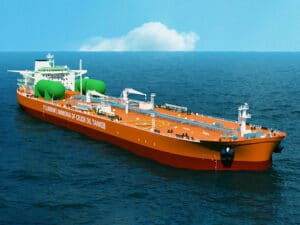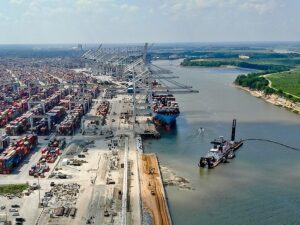
DNV unveils concept design for LNG-fueled VLCC
Written by Nick Blenkey Classification society DNV has taken the wraps off a new crude oil tanker concept. The Triality ship is fueled by LNG, has a hull shape that obviates the need for ballast water and very greatly reduces local air pollution. The concept vessel also recovers hundreds of tons of cargo vapors on each voyage and, says DNV, is “a major step towards the new environmental era for the tanker shipping industry.”
Classification society DNV has taken the wraps off a new crude oil tanker concept. The Triality ship is fueled by LNG, has a hull shape that obviates the need for ballast water and very greatly reduces local air pollution. The concept vessel also recovers hundreds of tons of cargo vapors on each voyage and, says DNV, is “a major step towards the new environmental era for the tanker shipping industry.”
Developed through a DNV innovation project, Triality — as its name indicates, fullfils three main goals: it is environmentally superior to a conventional crude oil tanker, its new solutions are feasible and based on well known technology, and it is financially attractive compared to conventional crude oil tankers operating on heavy fuel oil.

DNV CEO Henrik O. Madsen, who presented the new concept in its VLCC version in London today, says: “I am convinced that gas will become the dominant fuel for merchant ships. By 2020, the majority of owners will order ships that can operate on liquefied natural gas (LNG). As a leading class society, DNV has an important role to play in finding more environmentally friendly solutions for the shipping industry, and I’m proud of what has been achieved for the crude oil tanker segment through this innovation project that we are presenting today.”
Compared to a conventional VLCC with the same operational range and operating in the ordinary spot market, the Triality concept VLCC will:
- emit 34 percent less CO2
- eliminate entirely the need for ballast water
- eliminate entirely the venting of cargo vapors (VOCs)
- use 25 percent less energy
NOx emissions will be reduced by more than 80 percent while emissions of SOx and particulate matter will fall by as much as 95 percent.
The new concept tanker has two high pressure, dual fuel slow speed main engines fueled by LNG, with marine gas oil as pilot fuel. The next phase of the Triality concept development will review the use of dual fuel medium speed engines and pure gas engines.

Two IMO type C pressure tanks capable of holding 13,500 cu.m LNG – enough for 25 000 nautical miles of operation – are located on the deck in front of the superstructure. The generators are dual fuel (LNG and marine gas oil) while the auxiliary boilers producing steam for the cargo oil pumps operate on recovered cargo vapors (VOCs).
A traditional tanker in unloaded transit needs ballast water to obtain full propeller immersion and sufficient forward draft to avoid bottom slamming. Triality has a new V-shaped hull form and cargo tank arrangements that will completely eliminate the need for ballast water in the VLCC version of the desihn. There will also be much less need for ballast water on other kinds of crude oil tankers, such as Suezmax, Aframax and smaller ships.
The new hull shape results in a reduced wetted surface on a round trip and has a lower block coefficient and thus a more energy efficient hull.
A VLCC in unloaded transit will normally carry between 80,000 and 100,000 tons of sea water containing organisms that can cause damage when released into foreign ecosystems. In addition, a lot of fuel is needed just to transport this extra water. And initial coating and later maintenance of ballast tanks during operations are among a shipowner’s main concerns.
The Triality VLCC can collect and liquefy more than 500 tons of cargo vapors during one single round trip. These liquefied petroleum gases will then be stored in deck tanks and up to half will be used as fuel for the boilers during cargo discharge, while the rest can be returned to the cargo tanks or delivered to shore during oil cargo discharge.
“It is possible to develop an environmentally superior ship and be profitable at the same time,” says Mr. Madsen. “Our best estimate is an additional capital expenditure of 10-15 percent for a Triality VLCC newbuilding compared to a traditional VLCC. Even with this extra cost included, we estimate a reduced life cycle cost equal to 25 percent of the newbuilding cost for a traditional VLCC.
“Triality is a concept vessel and a shipbuilder will need to prepare a detailed design before the first Triality crude oil tanker can be constructed,” notes Mr. Madsen. “The Triality concept is based on well known and proven components and systems, so in principle a Triality crude oil tanker introducing all or some of the innovative elements in the concept can be designed today. I am convinced that the Triality concept will create great interest among shipbuilders and crude oil tanker operators, so that the first Triality crude oil tanker will leave a shipyard before the end of 2014.”
Introduction of the Triality follows DNV’s launch in April 2010 of a new concept design for a containership fueled by LNG — Quantum.
December 6, 2010





Leave a Reply
You must be logged in to post a comment.